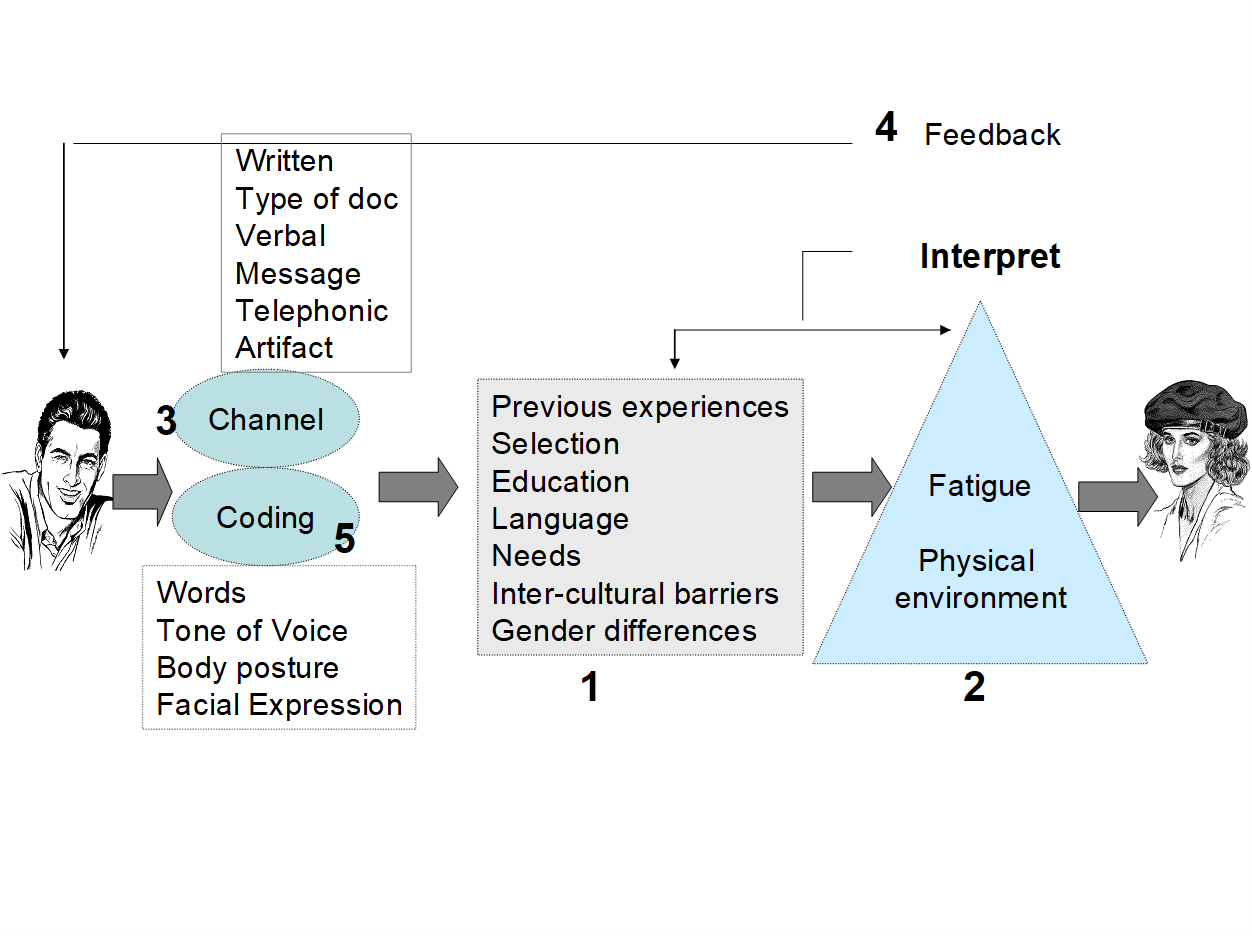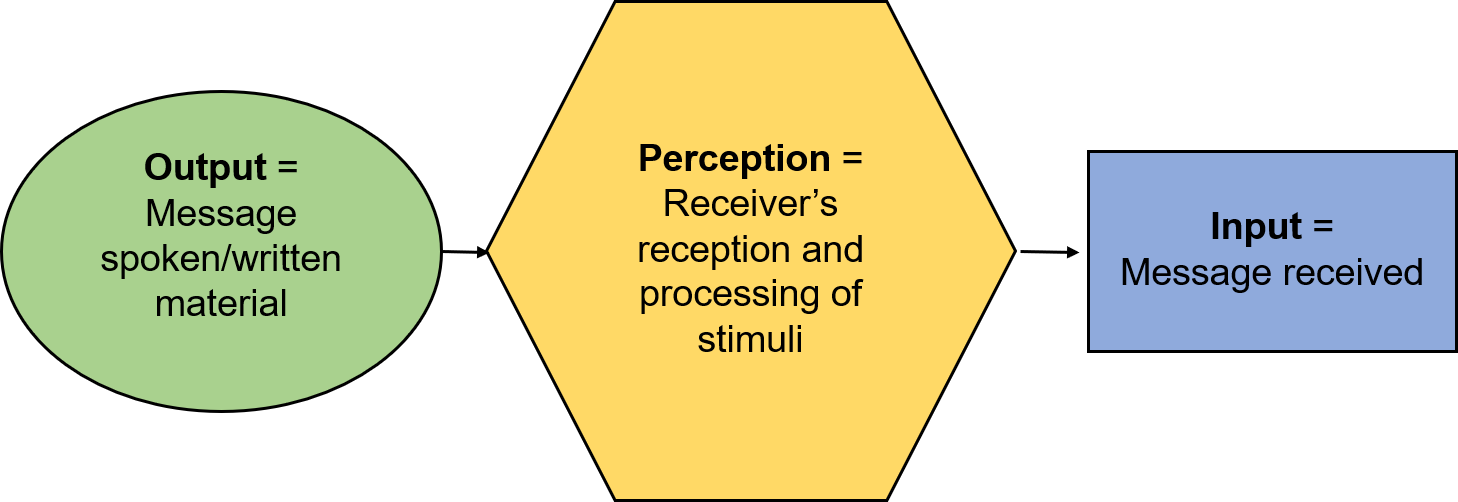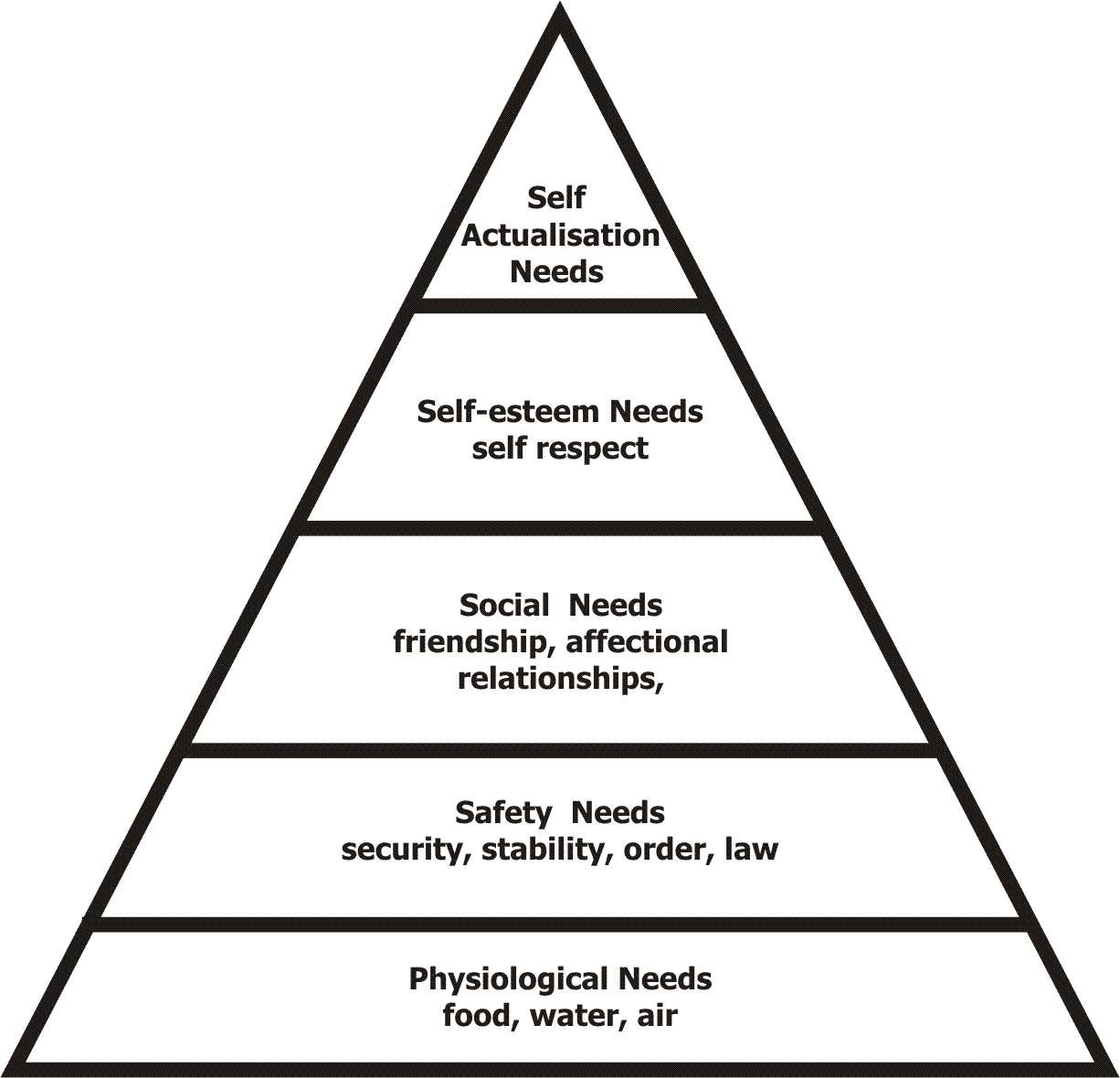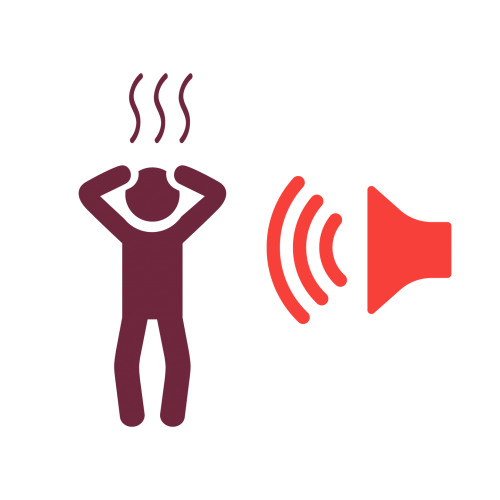The elements of the communication process also potentially become the barriers of the communication process.
The following categories of communication barriers can be identified:
- Frame of reference barriers
- Perceptual barriers
- Noise barriers
- Choice of medium barriers
- Feedback barriers
- Intercultural communication
- Communication between men and women

Barrier 1: Frame of Reference Barriers and Perceptual Barriers
Frame of reference is shaped by the person’s educational background, language proficiency, cultural background, intelligence, status, ego, emotions, beliefs, attitudes and values. A person’s frame of reference is not static and can change through life due to experiences over a lifetime. No two people have identical frames of reference. Perceptions are closely related to people’s frame of reference.
Perception is the process of selecting and organising information gained through the senses in such a way that it makes sense. It is a way of giving meaning to the world around us. A person bombarded with information has to select what is appropriate to him/her by filtering out unnecessary information. Because perception is selective no two people will experience or remember a certain situation exactly the same.
Communication is based on output and input. When a person receives input he processes it, filters out certain stimuli, gives meaning to it and form perceptions.

The processing that takes place occurs with lightning speed and usually subconsciously.
In communication with people in an organisation it is of the utmost importance to keep the other person/s frame of reference in mind and adapt communication accordingly. A breakdown in communication can occur if a person’s frame of reference is not kept in mind.
The following frame of reference and perception factors can cause communication breakdowns:
Past experience: Perception is learnt and shaped through experience. No two people have the same experiences throughout their life. People will therefore perceive the same experience in different ways. If a person had a near drowning experience as a child he will view water in a different light than everybody else. Water rafting as a team building exercise will definitely not be a good idea with this person.
Selection: A person selects or attends to what he/she likes or is familiar with. If a topic interests the person or is relevant to his work he will attend to what is being said and accept and file the information into his reference system. He will in remember what was said or discussed.

Needs: A person is influenced by his physical and psychological needs. Maslow’s hierarchy of universal human needs (1953) are still relevant today.

Maslow’s Hierarchy of Needs
If a person’s basic needs are not fulfilled, how can you expect the person to reach his full potential? If a person is hungry he will think about food instead of the task at hand or if he feels he cannot trust the organisation he will definitely not be open in his communication with his superiors.
A good communicator strives to meet the needs of the receiver so that unfulfilled needs do not become barriers.
Education and environment: The education and the environment in which a person grow up shape the person’s perception. People from different backgrounds and education may perceive a situation totally different e.g. a doctor and a person driving a tow truck will perceive the scene of an accident totally different.

Language: To be able to understand a verbal message, the person receiving the message has to be conversant in that language. Even if a person understands the code of the particular language people still perceive language differently.
If a manager uses high flown language that is not in the vocabulary of the receiver of the message their can be no mutual understanding.
For example: “I don’t want you to sit on it” can be interpreted in different ways by the person receiving the message. The manager meant: “I want the report immediately.” The worker just ready to sit down, interprets the message as: “Do not sit on that couch."
Intercultural barriers: People from the same culture share values, beliefs, certain rules and language. People are subjected to other cultures on a daily basis because the world is shrinking due to instant global communication. People need to be informed about the different cultures that they are dealing with. South Africa itself has a diverse population consisting of different cultures and ethnic groups. Each group has its own uniqueness and cultural characteristics although we share some common characteristics such as geography and laws.

According to Cleary, 2003, p.29, some of the areas that communicators in South Africa should be sensitive about are:
Personal contact: Some communities prefer closer personal contact than others. Standing too close to people may offend them.

Touching: Touching may be the norm in some cultures while others may regard it as too intimate
Eye contact: Rules about eye contact also differ in cultures. Children may be regarded as impolite if they look a parent in the eye and in another culture avoiding eye contact may be seen as an acknowledgement of guilt.
Time: In Western cultures time is especially important. Being on time, starting on time, meeting deadlines are valued attributes. Some cultures are less precise about time – more or less is good enough.
Individual orientation: In some cultures more value is placed on individual achievement and in others value lies in participation in the community.

Conciseness: In some cultures conciseness is very important. Others prefer a slower and dignified mode of interaction.
Directness: Some cultures perceive directness as impolite and value a more subtle approach.
Future orientation: For some groups the prospect of a better tomorrow is a strong motivating force. They value youth as holding the key to the future. Other cultures see life as part of an endless, cyclical process from birth to death. They are oriented towards the past and the here and now, rather than the future. They have great respect for age and for ancestral spirits.
Barriers to intercultural communication may arise if people view their own culture as superior to that of others and regard the other culture as wrong.
Different verbal and nonverbal codes that differ in cultures may also lead to communication barriers.
Cultural stereotyping is also one of the pitfalls of intercultural communication e.g. all white people are racist; black people are always late; all Americans are loud talkers, etc.
In South Africa intercultural contact mostly takes place in organisations. Organisations therefore have a very important role to play in influencing behaviour and developing positive relationships.
Think about intercultural communication under the following:
- What is the correct form of greeting people in your culture?
- How do you show respect to older/senior people in your culture?
- What is the accepted norm for personal space during face to face communication in your culture?
- How much eye contact is allowed in your culture?
- How much physical contact is allowed in your culture?
- Is the public display of emotions allowed in your culture?
- Is the use of certain words taboo in your culture?
- Is the use of certain nonverbal behaviours not allowed in your culture?
- How does your culture view time?
- What is the correct procedure in your culture to follow when you are ill?
Communication barriers between men and women: Research done provides important insight into the differences between men and women in terms of their conversational styles. According to Tannen (Robbins 2001, p.296) men are more likely to use talk to emphasize status while women are more likely to use it to create connection. Women speak and hear a language of connection and intimacy; men speak and hear a language of status, power and independence. Men are more direct in their communication e.g. “these figures are wrong” opposed to “perhaps you have to check these figures”. Other differences include pitch of voice, use of body language, use of verbal language, narrative style, etc.
Both sexes have to be aware of the differences in communication styles between men and women in order to avoid differences becoming communication barriers.

Barrier 2: Noise Barriers
Any distortion or disruption in the communication process can be referred to as noise. Noise can be physical or psychological.
Physical noise can be any background noises e.g. a noisy fan, people talking or interrupting, telephones ringing, a very cold room, etc.
Psychological noise is the noise going on in the mind of the person receiving the message. The person may be distracted because of emotional problems or negative feelings towards the sender of the message. Information overload is also a factor in modern society.
The demands of keeping up with e-mails, phone calls, faxes, meetings and professional reading material create an onslaught of data that is nearly impossible to process and assimilate. Spelling mistakes, bad pronunciation, ambiguous sentence construction and poor layout of written material can all interfere with the clearness of the message and can be regarded as noise barriers.
Management and workers should always be aware of the possibility that misinterpretations and misunderstandings may occur because of noise barriers.

Barrier 3: Choice of Medium Barriers
The choice of communication medium, e.g. telephone, e-mail or face-to-face is very important in getting the message across. Electronic media no longer make it necessary for people to be at their work stations or desks all the time because they can be reached via cell phones or pagers. Networked computers make organisational boundaries less relevant because employees can jump vertical levels much easier.
Why do people choose one medium over another? Time and cost are factors but communication apprehension or anxiety also plays an important part. People may be afraid to speak in front of a group, or use the telephone, or they are not comfortable with writing letters or memos. People will avoid situations where they have to use a certain medium and that influence communication negatively. Telephoning an important message can result in misunderstandings because there is no written material that can be referred to. Sensitive issues may be handled better in face to face situations than over the telephone or via e-mail.

Barrier 4: Feedback Barriers
While a person is sending a message the receiver will give a response/feedback. If the receiver does not understand the message or the message is not clear the sensitive sender will make adjustments to the message in order to clear up uncertainties. He will adapt, restructure or paraphrase. If the message is in written form, e.g. an advertisement or editorial the medium does not allow for immediate feedback. Face to face and telephone conversations allow for constant feedback. During telephone messages nonverbal elements cannot be perceived and that may hamper communication.

Barrier 5: Coding Barriers
Certain words or gestures may be offensive to people and should be avoided in order not to create communication barriers. This is especially important if the employee works with customers. It may be offensive to speak of a person as “the old man” in stead of the “elderly gentleman” or “the senior person”. Words like “blind” may be substituted with “visually impaired”. In a business familiarity can also offend e.g. addressing a person by his/her name instead of Mr. or Ms. Somebody. Gestures such as pointing fingers, crossing arms and frowning may also be offensive.
